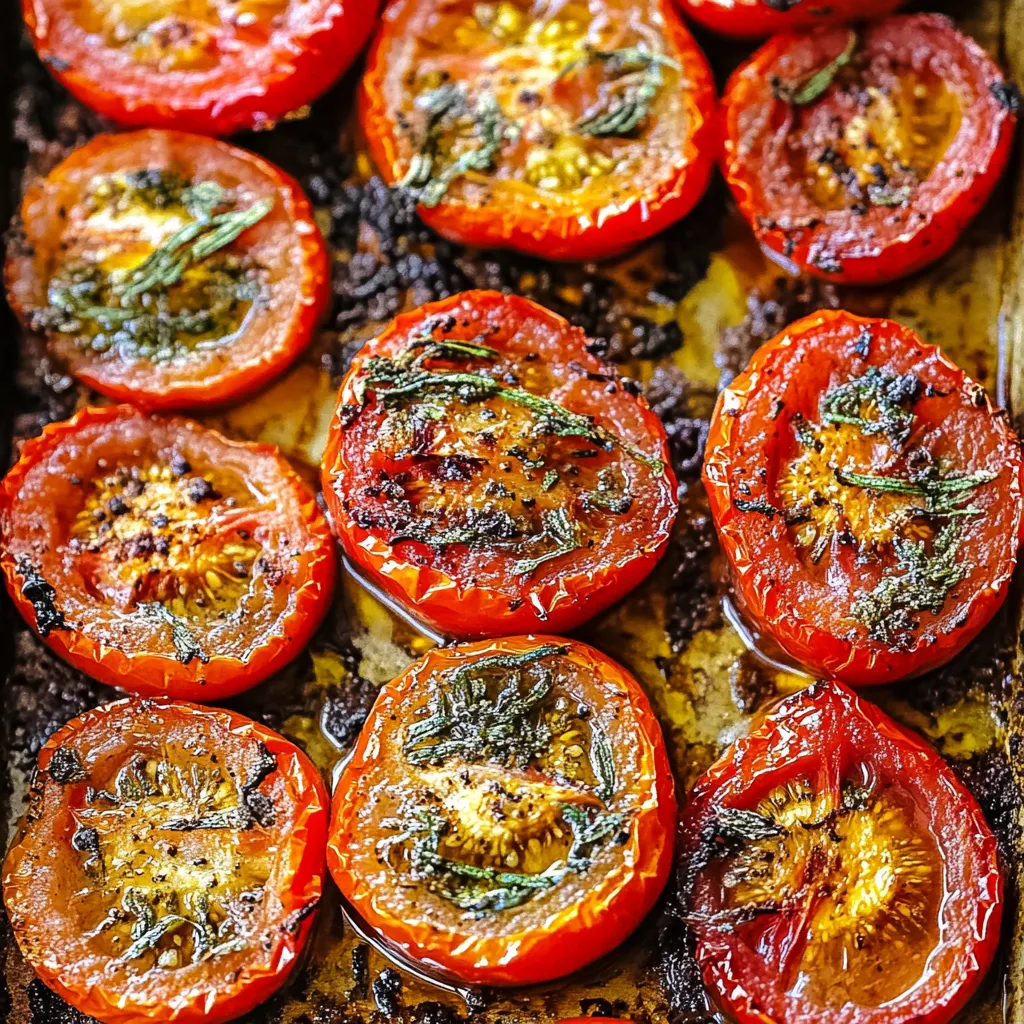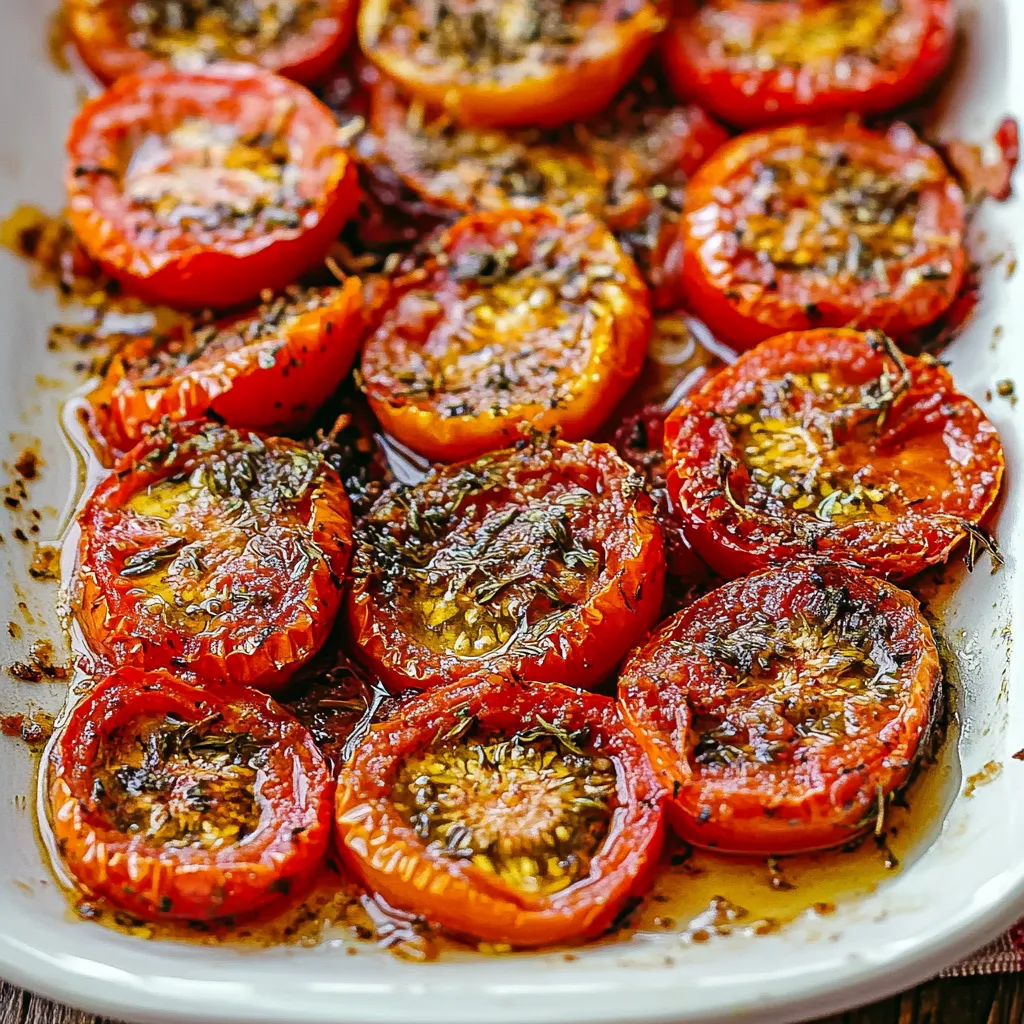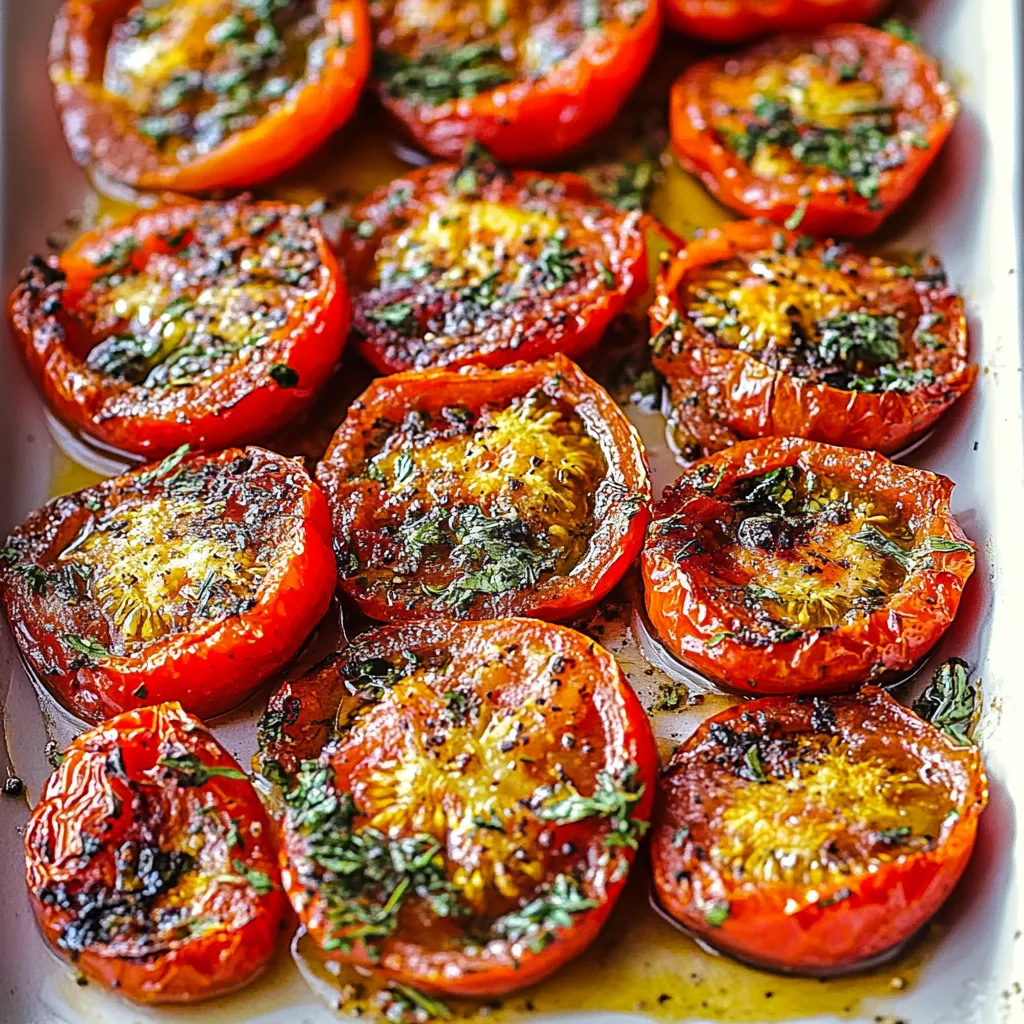 Pin it
Pin it
This slow roasted tomato confit transforms ordinary Roma tomatoes into an intensely flavored, sweet and jammy spread that elevates everything from crusty bread to pasta dishes. The long, gentle cooking process concentrates the natural sugars in the tomatoes while infusing them with aromatic herbs and garlic.
I discovered this recipe through my mother in law who served it at a summer gathering years ago. The moment I tasted it spread on rustic bread, I knew I needed the recipe in my life forever. It has since become our family's signature hostess gift.
Ingredients
- Roma tomatoes: Choose firm, ripe tomatoes with minimal blemishes for the best flavor concentration
- Garlic: Very finely diced to infuse the oil without overwhelming chunks
- Salt: Enhances flavor and draws moisture from tomatoes
- Fresh oregano: Adds an earthy, slightly bitter complexity
- Fresh basil: Contributes sweet herbal notes that pair perfectly with tomatoes
- Dried thyme: Provides subtle floral undertones that deepen during the slow roast
- Olive oil: Use a good quality oil as its flavor will concentrate during cooking
Step-by-Step Instructions
- Preheat Oven:
- Set your oven to 120°C or 250°F. This low temperature is crucial for slow roasting without burning the tomatoes.
- Prepare The Tomatoes:
- Bring a large pot of water to a rolling boil while preparing a bowl of ice water nearby. Score each tomato with two perpendicular cuts on the stem end using a sharp knife. Blanch tomatoes for about 15 to 20 seconds before transferring to ice water. The skins should now slip off easily. If resistance occurs, give them another quick dip in the boiling water.
- Slice And Drain:
- Cut each peeled tomato lengthwise into slices approximately 2 cm or 1 inch thick. Gently squeeze each slice between your palms to remove excess moisture. This prevents a watery final product.
- Preliminary Drying:
- Line baking sheets with kitchen towels or paper towels and arrange tomato slices cut side down. Sprinkle with about half a teaspoon of salt total and let them rest to draw out more moisture while preparing the oil mixture.
- Create Herb Oil:
- Finely mince or crush the garlic cloves and combine with olive oil, chopped fresh herbs, and dried thyme in a small bowl. Stir thoroughly and allow to sit for at least 5 minutes so the flavors begin to infuse the oil.
- Arrange For Roasting:
- Transfer tomatoes to parchment lined baking trays, arranging them with some space between pieces for proper air circulation. Drizzle the garlic and herb oil evenly over each tomato slice, ensuring even coverage.
- Slow Roast:
- Place in preheated oven and roast for 4 to 6 hours. The exact time depends on your oven and the moisture content of your tomatoes. Look for them to deeply shrink, darken slightly around edges, and take on a jammy consistency without burning.
 Pin it
Pin it
The oregano in this recipe reminds me of my mother in law's garden where she grows it in abundance. She taught me that crushing the herbs between your fingers before adding them to the oil releases their essential oils and intensifies their flavor in the finished confit.
Storage Information
This tomato confit will keep refrigerated for up to three weeks when stored properly. Transfer the cooled confit to a clean glass jar and pour a thin layer of additional olive oil on top to create a seal. This prevents air from reaching the tomatoes and extends shelf life significantly. The olive oil will solidify slightly when chilled but returns to liquid when brought to room temperature before serving.
Serving Suggestions
The intense flavor of this confit makes it incredibly versatile in the kitchen. Spread it on crusty bread or crackers for an instant appetizer. Toss with hot pasta and a sprinkle of Parmesan for a quick dinner. Use as a flavor base for soups and stews or spoon onto grilled meats and fish just before serving. One of my favorite applications is stirring a tablespoon into scrambled eggs for an elevated breakfast.
Recipe Variations
While this classic version uses traditional Italian herbs, the recipe welcomes adaptations. For a Spanish twist, substitute smoked paprika for thyme and add thin strips of roasted red pepper. Create a Provence version with herbes de Provence and lavender. For heat lovers, incorporate thinly sliced chili peppers or red pepper flakes into the oil. The technique remains the same while the flavor profile can travel the world.
 Pin it
Pin it
This tomato confit is a game changer in the kitchen—simple to make, yet extraordinary in its versatility and flavor.
Frequently Asked Questions
- → How long will this tomato confit keep in the refrigerator?
When stored properly in an airtight container and covered with a layer of olive oil, this tomato confit will keep for up to 2 weeks in the refrigerator. The oil acts as a natural preservative by creating a barrier against air.
- → Can I use different types of tomatoes for this confit?
While Roma tomatoes are ideal due to their meaty texture and lower water content, you can substitute other varieties like plum or cherry tomatoes. Just be aware that juicier varieties may require longer cooking time to achieve the same concentration.
- → What are the best ways to serve tomato confit?
This versatile confit shines when spread on crusty bread or crostini, tossed with pasta, layered in sandwiches, or used to enhance sauces. It also makes an excellent addition to cheese boards or as a topping for grilled meats and fish.
- → Can I freeze tomato confit?
Yes, tomato confit freezes well. Portion it into ice cube trays or small containers, leaving some headspace for expansion. Once frozen, transfer to freezer bags and store for up to 3 months. Thaw in the refrigerator before using.
- → Can I add different herbs and spices to customize the flavor?
Absolutely! While this version uses garlic, oregano, basil, and thyme, you can experiment with rosemary, sage, red pepper flakes, bay leaves, or even fennel seeds. Just ensure herbs are finely chopped to infuse properly during the slow roasting process.
- → Why is it important to squeeze out excess liquid from the tomatoes?
Removing excess liquid before roasting significantly reduces cooking time and helps achieve the desired jammy consistency. This step concentrates flavors more quickly and prevents a watery final product.
